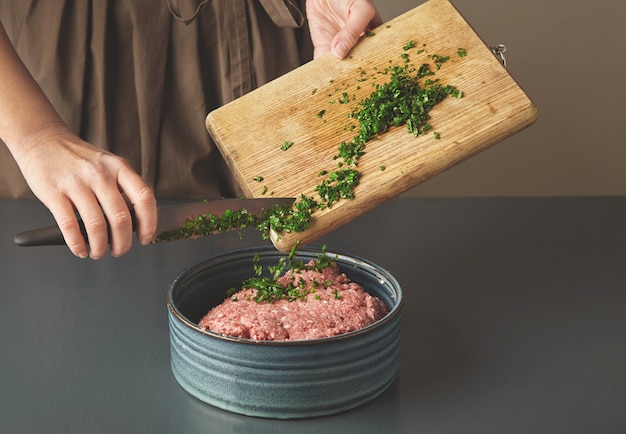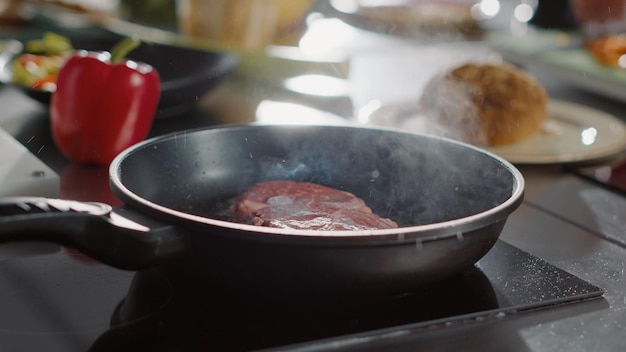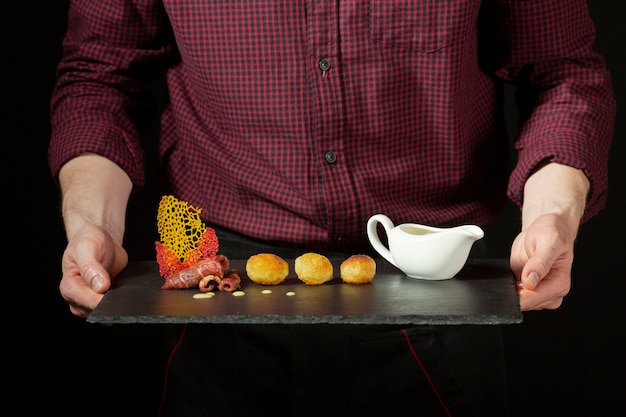Right, let’s talk corned beef. I've been making this classic dish for years, and over time, I've learned a thing or two about achieving that perfect, melt-in-your-mouth tenderness. I've tried every trick in the book: slow-cooking in the oven, pressure cooking, you name it. But for me, nothing beats a good old-fashioned stovetop simmer. The slow, gentle heat creates a symphony of flavors and transforms a tough cut of meat into a culinary masterpiece.
This guide is your roadmap to a perfectly cooked corned beef that will have everyone at the table begging for seconds. It's a simple process, but like any good recipe, a bit of attention to detail makes all the difference. So, grab your favourite apron, let’s get cooking!
(Part 1) The Essentials: Choosing Your Beef

The first step, and arguably the most important one, is picking the right corned beef. You’ll want to head to your local butcher or a good quality supermarket. It’s worth taking the time to find a butcher you trust, as they can often give you excellent advice on selecting the best cut for your needs.
1.1 Know Your Cuts
There are a few different cuts of beef used for corned beef, but the most common is the brisket. This tough, flavorful cut is perfect for slow cooking. As it simmers, the connective tissues break down, creating a melt-in-your-mouth texture that’s truly divine.
If you're looking for a leaner option, you could go for a flat cut brisket, also called a first cut brisket. This is the leaner part of the brisket and cooks up beautifully. Just keep a close eye on it to ensure it doesn’t dry out.
1.2 Size Matters
The size of your corned beef will influence your cooking time. I personally prefer a brisket that’s around 4-5 pounds, just because it’s a good size for feeding a family. But you can get smaller or larger cuts, depending on your needs.
1.3 Checking for Quality
When you're at the butcher counter, take a minute to inspect the meat. Look for a good, even layer of fat on the top of the brisket. This fat will help keep the meat moist during cooking. And be sure to smell it. It should have a fresh, slightly salty aroma.
If you're buying pre-packaged corned beef, check the packaging date and make sure it’s recent. And don't be afraid to ask your butcher for their recommendations on the best quality. They're the experts, after all!
(Part 2) Preparing the Corned Beef

Now that you have your chosen cut of beef, it’s time to get it ready for the big event. This stage is pretty straightforward but will ensure your corned beef is a winner.
2.1 Rinse and Remove the Packaging
The first thing you’ll want to do is give the corned beef a good rinse under cold water. This washes away any excess salt and helps freshen the meat. Then, remove any packaging or netting that might be around it. I usually just pull it off, but if you're finding it stubborn, a sharp knife can help.
2.2 Trim the Fat
Now, take a look at the fat layer on top. It's important to trim off any excess fat, especially if you want a leaner corned beef. You can leave a thin layer for flavour and moisture, but don't overdo it. I tend to trim it down until I see a thin layer of white fat covering the meat.
Be careful not to trim too much fat, as this can lead to a drier corned beef. It's all about finding a good balance. And hey, even if you do trim off a bit more than you meant, don't worry! You can always add a bit more fat back in later on.
(Part 3) The Stovetop Method: Slow and Steady Wins the Race

Now, let’s get to the heart of the matter – the stovetop method. This is my favourite way to cook corned beef because it’s incredibly simple and produces the most tender results.
3.1 Choosing Your Pot
The first thing you need to do is find a large pot or dutch oven that can comfortably hold your corned beef. You want it to fit with some room to spare, as it’s going to need to sit in a good amount of liquid.
3.2 The Liquid: A Symphony of Flavors
This is where you can really add some personality to your corned beef. It’s all about the broth. You’ll need a good amount of liquid to cover the meat completely. There are a few common approaches:
- Simple and Effective: You can use just plain water, but I prefer adding some flavor. I usually start with a mixture of water and beef broth.
- Spice it Up: I love adding vegetables to my broth. A couple of carrots, an onion, and some celery are my go-to. They give the broth a lovely sweetness and make the whole dish more flavorful.
- Get Creative: Feeling adventurous? You can add other spices and herbs. A bay leaf is always a winner, and a few peppercorns add a touch of spice. You can even add a sprig of fresh thyme or rosemary for a more aromatic broth. Remember, the possibilities are endless! You can use your favorite spices to create a broth that reflects your unique taste.
3.3 Time to Cook: Patience is Key
With your corned beef nestled comfortably in its broth, it’s time to let it simmer away. A general rule is to cook the corned beef for 30-45 minutes per pound – this ensures that it becomes super tender and juicy. However, as I always say, you’ll know it’s ready when it’s ready.
After about 3 hours, use a fork to gently pierce the meat in the thickest part. If it easily enters with minimal resistance, you’re on the right track. If it’s still tough, continue simmering for another 30 minutes to an hour. I'm a bit of a stickler for this and usually like to cook for about 4 hours, just to make sure it’s really fall-apart tender.
3.4 Keeping it Warm: Rest is Essential
Once your corned beef is cooked to perfection, you don’t want to rush it out of the pot. Let it rest in the broth for at least 30 minutes before you try to carve it. This will allow the meat to continue absorbing flavour and make it even more tender.
While it’s resting, you can skim off any fat that has accumulated on the surface of the broth. It’s up to you if you want to discard it or save it for later use. I tend to keep it to make a rich and flavorful gravy later on.
(Part 4) The Magic of the Meat: Carving and Serving
Now comes the fun part - carving the corned beef. This is where you get to see all your hard work pay off.
4.1 The Carving
Use a sharp carving knife to slice the corned beef thinly against the grain. This will help you get the most tender and juicy slices. If you're using a brisket, try to get those beautiful, thin slices that you can easily fold. It's a classic for a reason.
If you’re working with a flat cut brisket, you can get away with slicing a bit thicker. It still needs to be easy to slice and tender, but you can carve it a bit more like a roast.
4.2 The Sides: Creating a Feast
Now, you’ve got your perfectly cooked corned beef, and it’s time to create a feast. You’ve got a few options here. The classic way to serve corned beef is with a side of boiled potatoes, cabbage, and carrots. This is a combination that’s hard to beat! The potatoes are creamy and filling, the cabbage adds a bit of sweetness, and the carrots add a touch of color and freshness.
But feel free to get creative. Some other delicious sides include:
- Roasted vegetables: sweet potatoes, Brussels sprouts, or asparagus all go well with corned beef.
- Savoury bread: A crusty sourdough or rye bread is perfect for soaking up all the delicious juices.
- A fresh salad: For a lighter touch, a simple green salad with a tangy vinaigrette can be a nice counterpoint to the rich corned beef.
4.3 The Gravy: The Final Touch
And finally, don’t forget the gravy! The broth from the cooking process makes a fantastic gravy. Simply skim off any fat from the surface of the broth and pour it into a saucepan. Bring it to a boil, then reduce it over medium heat until it thickens. You can then strain it to remove any bits of vegetables or spices. I like to add a tablespoon of butter and a teaspoon of flour to the gravy just before serving, for a richer, smoother texture.
Now, you've got a meal that's sure to impress. This is the kind of dish that makes people happy.
(Part 5) Leftovers: A Treasure Trove of Possibilities
Speaking of making people happy, let’s talk about leftovers. This is where the magic of corned beef truly shines. You can use those delicious leftovers in a whole bunch of different ways.
5.1 The Sandwich: A Classic
Let’s be honest, a corned beef sandwich is practically a national treasure. There’s something about the salty, tender meat piled high on a soft, crusty roll, slathered with mustard, that just hits the spot.
You can get fancy with your corned beef sandwiches. Add a layer of Swiss cheese, some sauerkraut, or even a dollop of horseradish for a kick. Or keep it simple with just mustard and a slice of tomato.
5.2 Hash: A Hearty Meal
If you want something a bit more substantial, try making corned beef hash. It’s a classic dish that's perfect for breakfast, lunch, or dinner. Just dice up the leftover corned beef and fry it with some diced potatoes and onions. You can add a bit of pepper and other spices to taste. You can even add a poached egg on top for a decadent meal.
5.3 Soup: A Comforting Comfort
corned beef soup is another great way to use up leftovers. It’s a warm and comforting soup that's perfect for cold days. You can use the broth from cooking the corned beef as the base, then add the leftover meat and some vegetables. You can even add some noodles or rice to make it a heartier meal.
5.4 The Possibilities are Endless: Let your Imagination Run Wild
The beauty of corned beef leftovers is that you can really use them in just about anything. Get creative and experiment! Add them to a casserole, stir-fry, or even a pasta dish. The possibilities are truly endless!
(Part 6) FAQs: The Questions You May Have
I know, I know, you're probably full of questions after all this corned beef talk. So, let’s tackle some frequently asked questions.
6.1 Can I Cook Corned Beef in the Oven?
You certainly can! If you prefer oven cooking, you can cook it in a large roasting pan. Add some liquid, like broth or water, to the bottom of the pan and place the corned beef on a rack over the liquid. Cook it at 325°F (160°C) for 3-4 hours, or until it's tender. You can even add some vegetables to the pan, just like you would on the stovetop.
6.2 What if I Don’t Have Beef Broth?
Don’t worry, plain water will do just fine. You can also use chicken broth if you prefer. I've even used vegetable broth before, and it worked out perfectly. You can also try adding a bouillon cube to your water for a little extra flavor.
6.3 How Long Can I Keep Leftovers?
Store any leftovers in the refrigerator for up to 4 days. Make sure to refrigerate it in an airtight container. And if you want to store it even longer, you can freeze it for up to 3 months. Just be sure to let it thaw thoroughly in the refrigerator before reheating.
6.4 What’s the Deal with the Pickling Spice?
Some corned beef comes pre-packaged with pickling spice packets. It's your call whether you use them or not. I usually do, but it's not essential. If you want to add your own pickling spice, you can find it in the spice aisle of your supermarket. Just be sure to add it to the broth at the beginning of cooking.
6.5 Can I Use This Guide for Other Braised Meats?
You bet! This stovetop method works wonders for other braised meats, like chuck roast, pot roast, and even short ribs. You can adapt the recipe by adjusting the cooking time and the flavorings to suit the particular type of meat.
(Part 7) A Final Word: Enjoy the Journey!
Well, there you have it, my friends! That’s my take on the perfect stovetop corned beef. Remember, cooking is all about having fun and experimenting. Don’t be afraid to try different things and find what works best for you. And most importantly, enjoy the process and the delicious results. Happy cooking!
(Part 8) The Ultimate Corned Beef Guide: A Table of Tips and Tricks
I’ve got a few more insider tips and tricks to share that will help you create a truly memorable corned beef experience.
| Tip | Explanation |
|---|---|
| Use a meat thermometer | To ensure your corned beef is cooked to perfection, use a meat thermometer to check the internal temperature. The corned beef is done when it reaches an internal temperature of 160°F (71°C). |
| Don't overcrowd the pot | Give your corned beef plenty of room to cook evenly. If you're cooking a large brisket, you may need to use a larger pot or even cook it in two batches. |
| Add a splash of vinegar | Adding a tablespoon or two of vinegar to the broth helps tenderize the meat and create a richer flavor. |
| Don't overcook the corned beef | Overcooked corned beef can become dry and tough. The best way to ensure your corned beef is perfectly cooked is to use a meat thermometer and check for tenderness. |
| Let the meat rest | After cooking, let the corned beef rest in the broth for at least 30 minutes before carving. This will allow the meat to continue absorbing flavor and become even more tender. |
(Part 9) A Touch of History: The Origins of Corned Beef
While it’s now a staple in many kitchens, corned beef has a fascinating history. The name “corned beef” actually comes from the large grains of salt (called “corns”) used to preserve the beef.
The process of corning beef dates back centuries, with evidence suggesting it was practiced as far back as the Roman Empire. The process of preserving meat with salt was essential for ensuring food preservation before the invention of refrigeration.
The corned beef we know today is largely attributed to Irish immigrants who brought their traditional recipes to the United States in the 19th century. It quickly became a beloved dish, particularly in working-class neighborhoods, as it was a cheap and nutritious source of protein.
(Part 10) Beyond the Basics: Exploring Different Styles
While the classic stovetop method remains a favorite, there are other delicious ways to cook corned beef. Here are a few to explore:
10.1 slow cooker Corned Beef
For a hands-off approach, you can cook corned beef in a slow cooker. Simply place the corned beef in the slow cooker with your chosen liquid and spices. Cook on low for 8-10 hours, or on high for 4-6 hours, until the meat is tender.
10.2 pressure cooker Corned Beef
If you're looking for a faster cooking method, a pressure cooker is a great option. Cook the corned beef in the pressure cooker with your chosen liquid and spices for about 60-90 minutes, depending on the size of the brisket.
10.3 grilled corned Beef
For a bolder flavour profile, try grilling your corned beef. This method adds a smoky flavor to the meat. You can grill it over direct or indirect heat, depending on your preference.
(Part 11) The Verdict: A Culinary Masterpiece
So, there you have it, folks! With a little bit of care and attention, you can create a perfect stovetop corned beef that will make your taste buds sing. It’s a dish that’s both classic and versatile, a true testament to the art of slow cooking. Whether you're a seasoned chef or a beginner in the kitchen, this guide has everything you need to conquer the world of corned beef. Now, go forth and cook!
Everyone is watching

How to Cook Frozen Lobster Tails Perfectly: A Step-by-Step Guide
RecipesLobster. Just the word conjures up images of lavish meals, special occasions, and a taste of luxury. But let's...

Pigs in a Blanket Cooking Time: How Long to Bake for Perfect Results
RecipesAh, pigs in a blanket. Just the name conjures up images of those delightful little parcels of crispy pastry en...

Pork Fillet Cooking Time: How Long to Cook It Perfectly
RecipesPork fillet, or tenderloin as it's sometimes called, is a real favourite in our house. It's so versatile, and...

The Ultimate Guide to Tender, Juicy Pulled Pork
RecipesRight, let's talk pulled pork. It's one of those dishes that just screams "comfort food," doesn't it? I mean...

The Ultimate Guide to Cooking Sweet Potatoes: From Roasting to Mashing
RecipesSweet potatoes. Just the name conjures up images of warm, comforting dishes, bursts of vibrant color, and a to...
